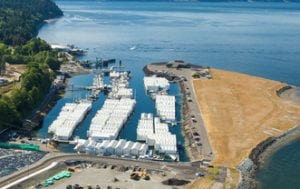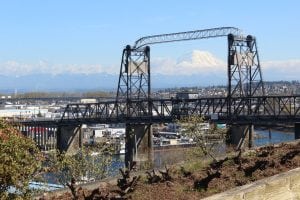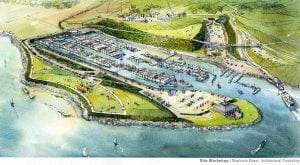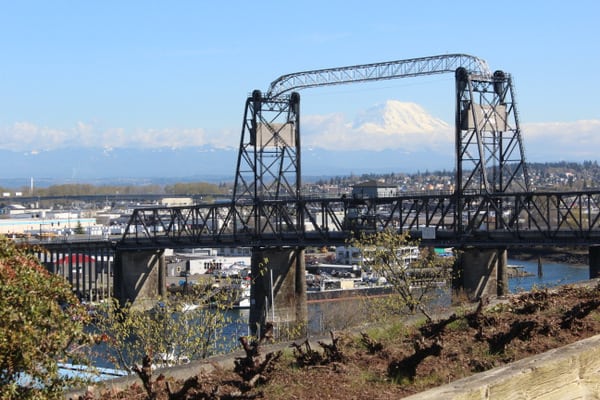An effort to honor Frank Herbert – the Tacoma-raised author of the sci-fi classic “Dune” series – with the naming of a peninsula park at Tacoma’s Point Defiance Park started years ago. It fizzled out right as construction was set to start. The rumbles have begun anew. Now that construction of the Destination Point Defiance project is underway, the move to name at least a portion of it after the eco-themed giant of science fiction is gearing up again.
MetroParks Tacoma’s Waterfront and Peninsula project will end with a new stormwater treatment facility, a new boat trailer parking area, a redesigned Pearl Street entrance, added trails, and a bridge for walkers and bikers that will connect to the Esplanade and that will offer paved pathway along the full length of the Foss Waterway and Commencement Bay. The crown jewel of the part of Metro Park’s slate of projects at Point Defiance is the creation of a not-yet-named, 11-acre peninsula park that would offer unobscured views of Puget Sound, Mount Rainier and Vashon Island.

An online petition started in 2013 to name the park after Herbert, and now has about 800 supporters, a number that will certainly grow as the parks commission ponders what to call park when it opens in the fall of 2018.
One of those supporters is Tacoma author and MetroParks Commissioner Erik Hanberg. He notes that the waterfront site is particularly fitting to bear Herbert’s name since the central theme of environmental degradation borne by industrialization found in the “Dune” series played out during Herbert’s time in Tacoma, particularly with the former ASARCO copper smelter spewing lead and arsenic into the air for decades. The former location of the ASARCO smelter sits near the waterfront park.
“It certainly has some symbolism there,” Hanberg says. “I love the idea of naming the park after Frank Herbert, but I would like to hear what the people want.”
The parks commission hasn’t taken any formal action about park naming at this point, but that will change as the park takes shape. The commission will ultimately decide on a name after a public process, according to parks spokesman Michael Thompson.

Herbert is certainly a frontrunner. He was born in Tacoma and spent his early years in Tacoma, watching the pollution from the industrial waterfront that gave rise to the unfortunate “Tacoma aroma” from his window. He attended Stewart Middle School and Lincoln High School and grew up in several houses around the area, including ones on University Place’s Day Island, in South Tacoma, in Dash Point and in the East Side.
“He really was all over the city,” Hanberg says.
That transient fact translates into the lack of any monument or site name linking Herbert to the City of Destiny. In contrast, the house where the iconic crooner Bing Crosby was born and only lived for a few months as a toddler is a historical landmark. Herbert was inducted into the Science Fiction Hall of Fame in 2006, while the California State University Fullerton’s Pollak Library maintains a collection of his writings in a dedicated archive bearing his name. Even NASA has named geographic features on Saturn’s moon Titan and the Earth’s moon after words Herbert crafted to create the world described in the “Dune” series.
Herbert has no such honorary designation on any of the houses he once called home or elsewhere in the city of his youth. And he lived in Tacoma for years and formed the roots of what would later become known as the eco-fiction genre of science fiction in the city that has largely forgotten him. Herbert’s Tacoma years were spent hunting for game to feed the family and rowing or swimming between Gig Harbor and Tacoma in the days before the Narrows Bridge. He saw the effects of the industrial operations on Commencement Bay and the tideflats with each paddle of his oar. These images from his childhood and the future of the planet if unchecked pollution was allowed to continue formed the basis of his writing.

“Humans tend not to see over a long range. Now we are required, in these generations, to have a longer range view of what we inflict on the world around us,” Herbert said in “Dreamer of Dune,” a book his son wrote about him. “This is where, I think, science fiction is helping. I don’t think that the mere writing of such a book as “Brave New World“ or “1984” prevents those things which are portrayed in those books from happening. But I do think they alert us to that possibility and make that possibility less likely. They make us aware that we may be going in that direction.”
Herbert wrote his “Dune” series as less of a look into some hopeful dream where technology solved all troubles, but as a dystopian vision of the future after everything goes wrong. It was the world that was in stark contrast to other science fiction novels of the 1950s and 1960s. That contrast made it a classic of the genre, making it the best-selling science fiction novel of all time and the basis of a 1984 film of the same name by the notably quirky director David Lynch.













































